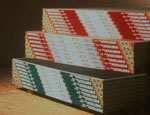 Sheetrock vs. Drywall, what is the issue. None really, it is mostly a difference in what you call the same product.
Sheetrock vs. Drywall, what is the issue. None really, it is mostly a difference in what you call the same product.
Are you involved in a 'Drywall Repair Project'? See the articles 'Drywall Patching', 'Repairing Water Damaged Drywall' and 'Taping and Mudding Drywall' for additional help.
What is Sheetrock?
To clarify, 'Sheetrock' is a brand name, owned by the United States Gypsum company. They have an entire line of products with the 'Sheetrock' designation, such as 'gypsum panels', 'joint compound' and 'joint tape'.
Sheetrock (used as a generic term), wallboard, drywall, plasterboard and sometimes, just plain 'rock', refer to paper faced panels with a gypsum core. In the last several decades, there have been several types and styles developed. Over the years, gypsum panels have replaced 'plaster' to provide smooth surfaces for walls and ceilings in many countries around the world.
So, officially, 'Sheetrock' is a Trade Name for a branded product, gypsum products manufactured by the United States Gypsum Company. What is interesting is that some dictionaries list it as a 'noun' the refers to paper faced gypsum panels. So, the name has been in use so long that some think of 'gypsum panels' as 'sheetrock', no matter what company actually made it.
The History of 'Sheetrock'
Lime based plaster has been around for thousands of years. Some of the famous architecture that we have admired down through the centuries employed various plastering techniques.
The problem with plaster is that when mixed and applied by hand, it is a fairly labor intensive activity. It also requires multiple coats to get the desired finish. Add to that the lengthy drying time that is often involved and you can see the need for a better product.
Toward the end of the nineteenth century, several manufacturers started using gypsum to replace lime based plaster. This material was cheaper and easier to deal with.
By the 1930's a paper faced sheet product had been developed that had a gypsum core. This was the forerunner of modern day gypsum panels that come in four foot wide sheets. Most homes in the united states have gypsum panel products fastened to the framing members to create a smooth wall surface. In fact, whether we realize it or not, very few people in this country can get through a day without seeing a wall or ceiling that has been covered by a gypsum panel product or 'sheetrock'.
The United States Gypsum Company has been and industry leader in gypsum based technology throughout the twentieth century and into this century.
Sheetrock vs. Drywall
Paper faced gypsum panels are now manufactured by several manufacturers. Each one has their own trade name for the materials that they produce.
So, what's in a name? If you are just referring to generic gypsum panels, not much. The names we call them tend to be localized, following certain regions in the country. The Midwest leans strongly toward 'Sheetrock', since USG is based in Chicago. Other areas around the country use 'wallboard', 'gyp-board', 'drywall', 'plasterboard', or 'rock' (my personal favorite), No crime using any of them.
Each manufacturer has many proprietary products that have unique features that might be important to us. A visit to each specific website will provide you information on these products.
Summary
Call it what you like, 'Sheetrock' or 'Drywall'. The fact is that gypsum based panels hold up the paint in most homes and businesses in the United States and many other countries around the world. It is a great labor saving product.

